Wave radiation and diffraction by a floating rectangular structure with an opening at its bottom in oblique seas *
Xiao-yan Yang (杨小岩), Hong-sheng Zhang (张洪生), Hai-tao Li (李海涛) ,3
1. College of Ocean Science and Engineering, Shanghai Maritime University, Shanghai 201306, China
2. State Key Laboratory of Ocean Engineering, Shanghai Jiao Tong University, Shanghai 200240, China,E-mail: yangxiaoyan@sjtu.edu.cn
3. College of Science and Technology, Agricultural University of Hebei, Huanghua 061100, China
Introduction
The wave interaction with floating structures has attracted many investigations of hydrodynamics during the past few decades due to its importance in the ocean engineering, the design of marine structures,and other fields, with extensive publications on the hydrodynamics of floating structures and significant achievements. To evaluate the hydrodynamic coefficients and the wave forces of the floating structures,various numerical and analytical methods are used with consideration of the interaction between the normal or oblique incident waves and the intact structures[1-6]. As a semi-analytical solution procedure,the method of separation of variables is commonly used. The method is principally used for rectangular and circular bodies. In the former case, the studies include the wave radiation due to oscillations of horizontal rectangular structures[7], the wave radiation and diffraction by an infinitely long rectangular structure floating on the free surface[8], the motion of a floating structure that restricts in some way the motion of a portion of the free surface[9], the two-dimensional piston-like steady-state motions of a fluid in a moonpool formed by two rectangular hulls[10], the motion of a damaged ship in waves based on a theoretical and experimental study[11], the radiation and diffraction problem of a two-dimensional rectangular body with an opening at its bottom floating on a layer of water of finite depth based on the linearized velocity potential theory and an analytical-numerical solution procedure[12], the wave radiation by an infinitely long rectangular structure floating on the free surface in oblique seas[13], the radiation and the diffraction of linear water waves by an infinitely long rectangular structure submerged in oblique seas of finite depth[2],the effects of a bottom sill on the hydrodynamic coefficients, the wave force, and the reflection and transmission coefficients of a rectangular structure floating on the free surface[14], and the diffraction of obliquely incident waves by a floating structure near a wall with a step-type bottom topography[15].
The method of separation of variables is also widely used for floating semicircular and circular cylinders. The studies include the complete solution of a floating semicircular cylinder in infinite water depth using the multiple expansion method[16], the second order wave diffraction and radiation as well the second order wave reflection and transmission by a horizontal cylinder in finite water depth[17].
In addition, there are some other methods for the wave interaction with floating structures, such as the radiation and the diffraction of a ship with a forward speed studied by using a time domain Rankine panel method[18]and the wavy (oscillatory both in space and in time) properties of free-surface flows due to presence of floating bodies analyzed within the framework of the potential-flow theory in the development of the multi-domain method[19].
In this paper, we consider the linear wave radiation and diffraction by a rectangular structure with an opening at its bottom floating on the free surface in oblique seas. This kind of structures can be seen in moonpools and damaged ships. Firstly, unlike the studies of the interaction between the normal incident waves and the structures, the governing equation for the radiated potentials and the diffracted potential is not the two-dimensional Laplace equation but the twodimensional modified Helmholtz equation. The wave excitation forces can be calculated from the incident and diffracted potentials. The focus is the effect of the incident angle on the hydrodynamic forces. Secondly,unlike the studies of the interaction between oblique waves and intact structures, we consider a rectangular tank with an opening at its bottom. Due to the existence of the opening, the external water will flow into a confined domain, which leads to a complex internal motion. In particular, a confined domain usually has a number or even an infinite number of natural frequencies. When the frequency of the incident wave or the motion of the structure is close to one of these frequencies, very large or violent liquid motions may be caused in the confined domain.
To the best of the authors’ knowledge, there are no analytical-numerical results reported for the radiation and the diffraction by a floating rectangular structure with an opening at its bottom in oblique seas.For this purpose, the wave diffraction and the wave radiations, including heave, sway and roll by a rectangular structure with an opening at its bottom floating in oblique seas are calculated by an analyticalnumerical method. The whole fluid domain is divided into several subdomains. The velocity potential in each subdomain is derived by using the method of separation of variables. The unknown coefficients are determined by the boundary conditions and the matching requirement on the interface of each subdomain. The results are verified through a convergence study, the symmetry property of the hydrodynamic coefficients and one specific example investigated previously. In addition, the effects of the angle of incidence, the width of the opening on the wave forces and hydrodynamic coefficients are discussed in detail.
1. Governing equation and boundary conditions
An infinitely long rectangular structure of width 2b and draught1h is floating on the water of constant water depth h. The structure has a hole of width 2a in the middle of its bottom. A Cartesian coordinate system oxyzshown in Fig.1 is employed with the origin at the undisturbed water surface. The z coordinate points upwards and thexaxis is directed to the right. Here it is assumed that the structure is infinitely long in theydirection and the incident wave direction forms an angle θ (0o< θ<90o)with the x-axis. The structure is vertically placed through the hull, the inside water is connected to the outside water with a cavity and a free liquid surface. Its upper part is not closed.

Fig.1 Sketch of geometric configuration
We assume that the fluid is inviscid, incompressible, and that the motion is irrotational, and so the fluid flow can be described by the velocity potential theory. It is assumed that the incoming wave is small, the motions of the structure are small, and the oscillations of the structure vary sinusoidaly in the y direction. The linear theory can be used (These assumptions were adopted by many researchers, as reviewed by Zheng et al.[13]). When the incoming wave is periodic both in the space and in time, the total velocity Φ can be expressed as

where Re[] denotes the real part of a complex function,, k is the wave number, ω is the angular frequency, φ(0)and φ(4)are the spatial velocity potentials due to the incident and diffracted waves, η(0)is the incoming wave amplitude,φ(l)(l=1,2,3)are the spatial velocity potentials for unit body displacement corresponding to heave(vertical), sway (horizontal) and roll (rotational)motions, respectively, and η(l)(l=1,2,3)are the corresponding motion amplitudes. Each of these potentials φ(l)(l=1,2,3,4)satisfies the following Helmholtz equation

The boundary conditions for each spatial potential are

in which ν = ω2/ g and the origin (0,0)taken as the centre of rotation, g is the acceleration of gravity,δjlis the Kronecker delta function given by


In the preceding equation, the incident wave can be written as for waves propagating in the water of depth h with an angle θ measured anticlockwise from the positive -xaxis. k can be determined by

2. Solution procedure
2.1 Expressions for the potentials
The eigenfunction expansion matching method is used here to solve the above boundary value problem analytically. The fluid domain is divided into sevenradiated potentials and the diffracted potential in theof separation of variables is applied in each subdomain to obtain the expressions for the unknown radiated potentials. The unknown coefficients in the expressions are determined by using the conditions of continuity of the pressure and the normal velocity at x=±a and x=±b.
With the method of separation of variables and taking into account of some of the boundary conditions, the potential in each subdomain can be expressed as:
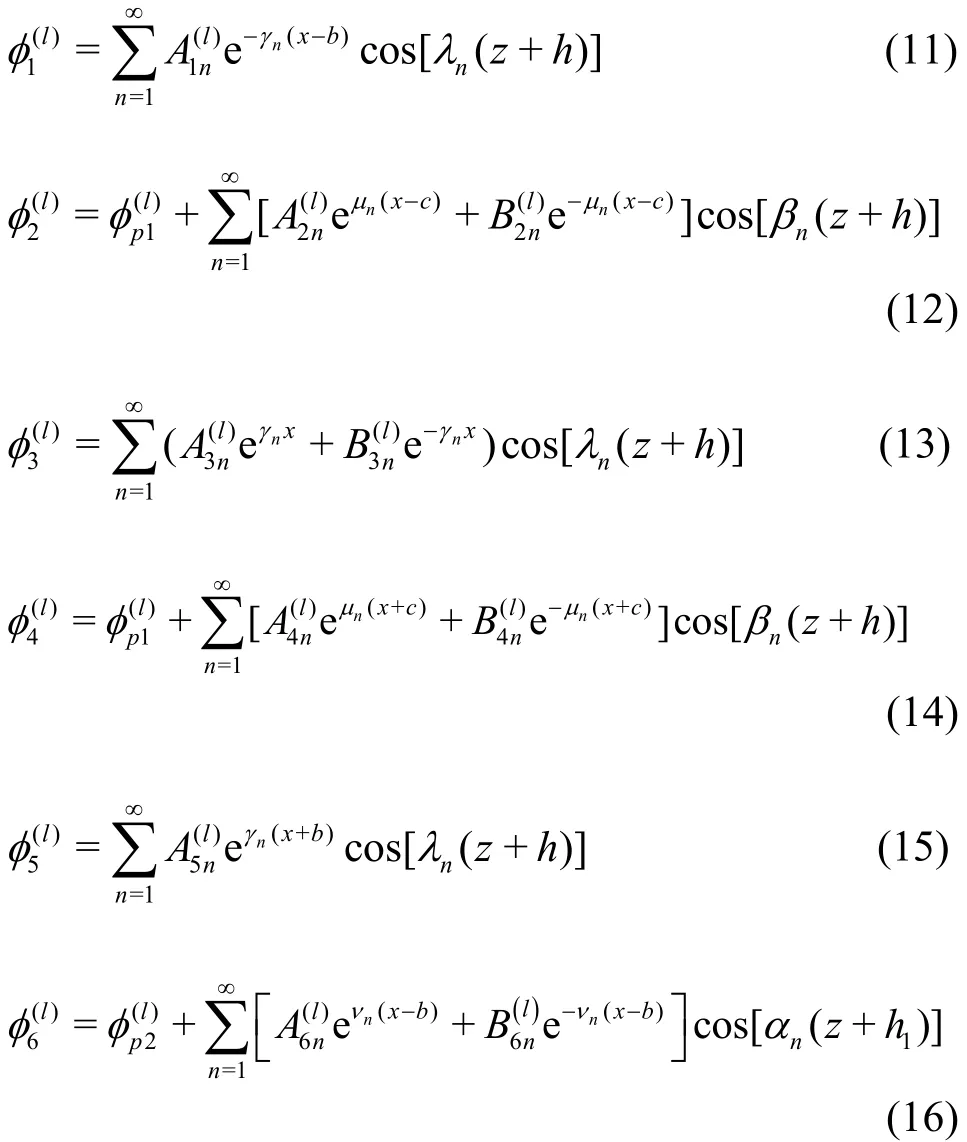

where

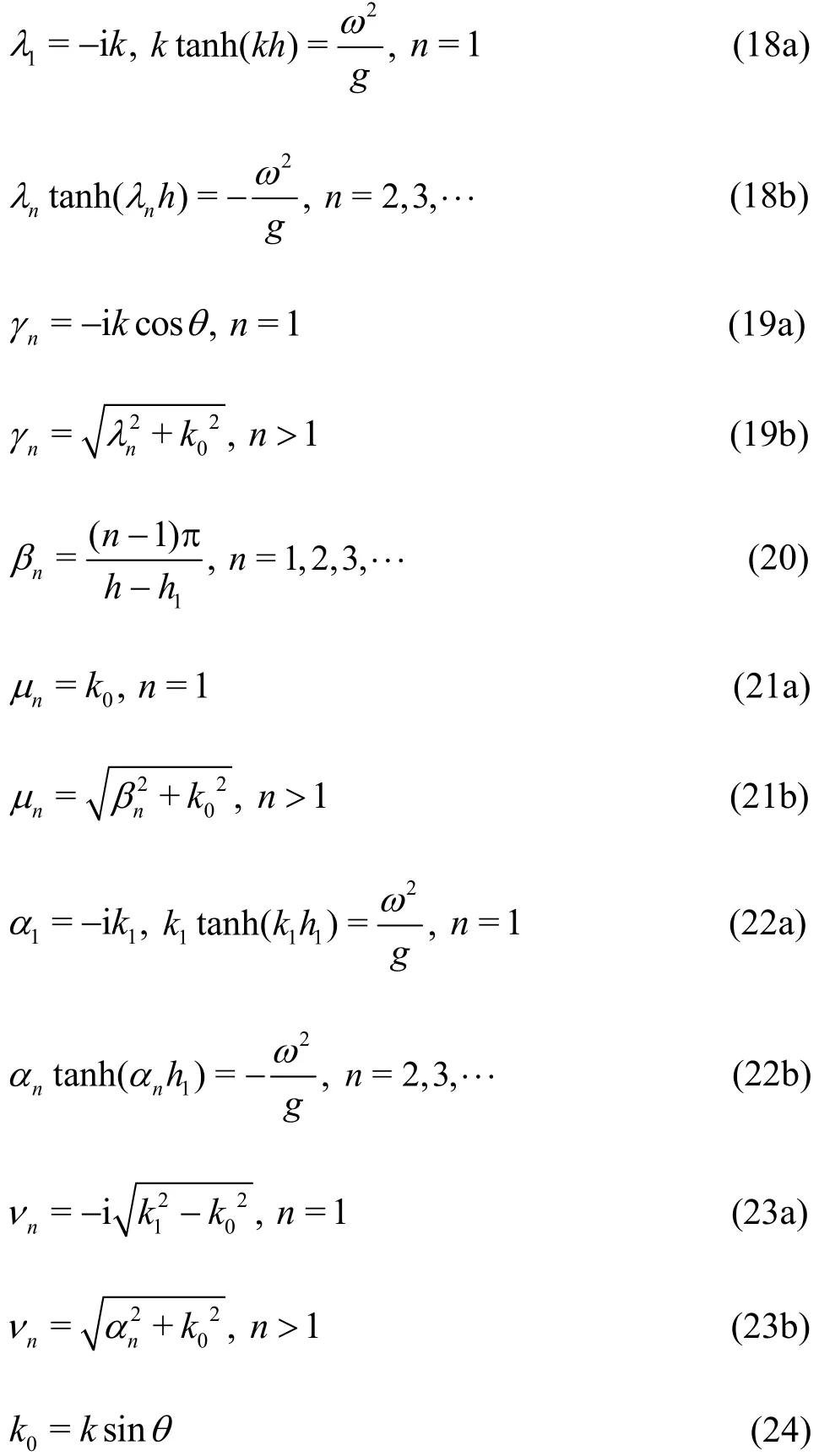

where

2.2 Solution for the unknown coefficients
Using the continuity conditions of the normal velocity and the pressure at each interface and the boundary conditions at =xb± and =xa±, we have
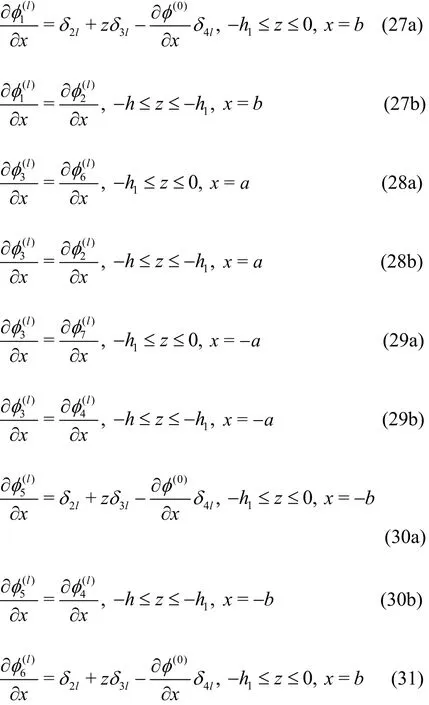


where
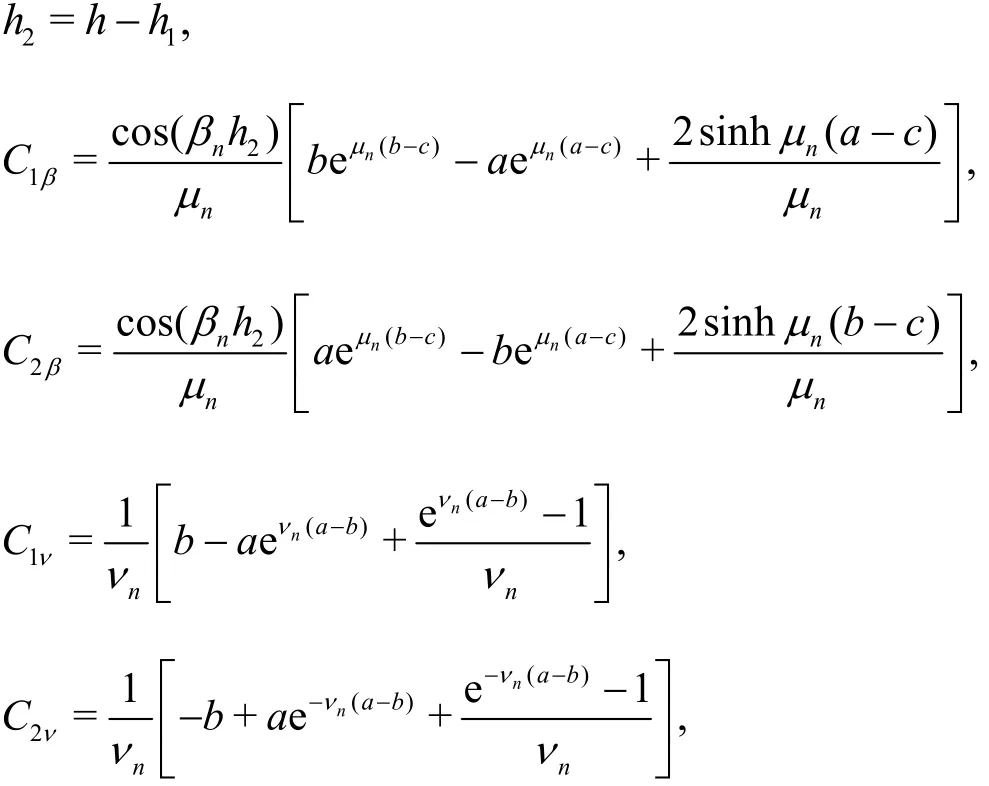
According to the method proposed by Zhou et al.[12], the differential equation of the boundary value problem can be converted into a set of linear equations.To obtain the specific solutions to the unknown coefficients, the infinite series must be truncated and the first N terms are taken. And it may be solved by the Gauss elimination method or some iteration method.The relevant details can be found in Zhou et al.[12].
3. Wave forces
3.1 Wave radiation force
Once the velocity potential is known, the hydrodynamic force on the body can be obtained from the integration of the pressure based on the linear Bernoulli equation over the wetted body surface. For the wave radiation due to the body oscillation, we have to consider the force in mode i due to the motion of unit amplitude in mode j

wherebS is the wetted body surface. This leads to
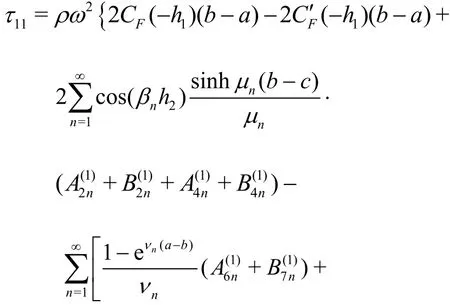

It is easy to see that there is a coupling between the sway and the roll. We have
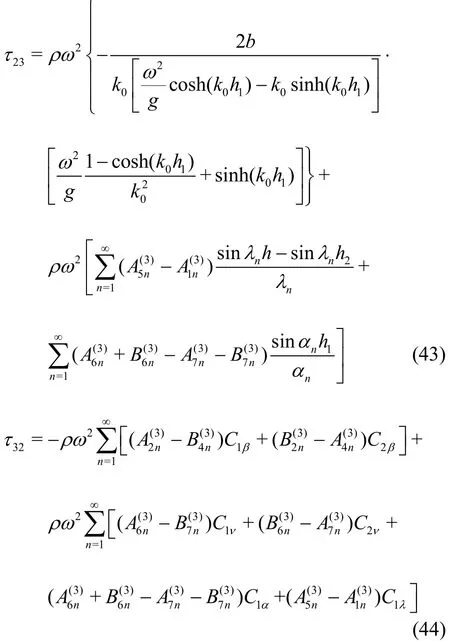
3.2 Wave excitation force
The wave excitation force on the body can be obtained from the incident and diffracted potentials.We have the vertical force

the horizontal force

and the rolling moment about (0,0)
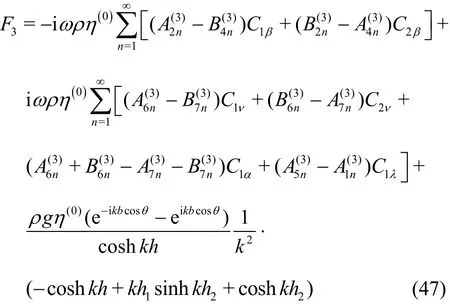

Fig.2 Symmetry between coupled sway and roll added mass and damping coefficients with θ = 30o, h/ h 1 =3,b/ h 1=0.5

Fig.3 Hydrodynamic coefficients and wave excitation forces in the case of normal incident waves h / h 1 =3, b / h 1 =0.5,a/ b=0.5
The force due to the wave radiation can be written in terms of the added massijμ and the damping coefficientijλ. They are generally called the hydrodynamic coefficients. With a dimensionless factorthe hydrodynamic coefficients are made dimensionless. The wave excitation forces can be non-dimensionalized as follows:


4. Validation
4.1 Convergence study
The infinite series considered in subsection 2.2 are truncated to keep the first N terms. A numerical experiment is performed to test the convergence of the hydrodynamic coefficients and the wave excitation forces with N terms. The results with N = 50 and N = 100 terms are very close, which means that N = 50 can provide a sufficient accuracy. Due to the space lim itati on, the ca lcu lation results are not presentedinthispaper. Inthefollowing discussions, all the hydrodynamic coefficients and the wave excitation force are calculated with =50N .

Fig.4 Effect of the size of the opening on hydrodynamic coefficients for the case of θ = 30o, h / h 1 =3, b / h 1=0.5 a/ b=0.5
4.2 Symmetry of hydrodynamic coefficients
It is well known that τij= τji(e.g., Mei[20]).These identities can be used for the further verification. Comparisons for the coupling between the sway and the roll are shown in Fig.2, and very good agreement can be seen.
4.3 Damping coefficients and excitation forces for the case of normal incident waves
The damping coefficients and the wave excitation forces for the caseof normal incident wavescalculated by the presentmethodand Zhouet are shown inFig.3, respectively. The resultsfrom the two methods are in excellent agreement.
5. Results and discussions
In this subsection, the effects of the width of the opening, the angle of incidence on the hydrodynamic coefficients and the wave forces are discussed, to shed some insight into the hydrodynamic behavior of the structure in oblique seas under different conditions.Only one parameter is varied each time. The discussions are based on the dimensionless quantities defined in Subsection 3.2.
5.1 Natural frequencies of sway motion of the closed tank (=0)a
From Wu[21], we have

Fig.5 Effect of the width of the opening on wave excitation forces for the case of θ = 30o, h / h 1 =3, b / h 1=0.5

When θ = 30o, Eq.(51) gives the first resonance in the sway at 2 k b≈ 3 .6207. Moreover, from Eq.(51),we can see that the external excitation frequency,leading to the resonance of a rectangular tank is not only related to the incident wave direction θ, but also related to its wave number k.
5.2 Hydrodynamic effects of the width of the opening
Consider the effect of the size of the opening on the hydrodynamic coef ficients for th e ca ses ofθ = 30o,h/ h1=3, b / h1=0.5.Simulationsaremadewhen a/ b = 0.2, 0.4, 0.6, and 0.8, respectively. The frequencies are in fact very much related to the resonance of a moon pool[22], as in the piston-like motion.Figs.4(c)-4(f) show that the behavior of the hydrodynamic coefficients for the sway and roll modes at different values of /a b is somewhat different. The peak values of the added mass at different values of a/b are taken as 0.2, 0.4, 0.6, and 0.8. The results for the heave added mass and damping coefficient at different a/b are shown in Figs.4(a) and 4(b). The differences between the curves of hydrodynamic coefficients are large. When there is an opening, the liquid flow which goes into and out of the tank will move the fluid in the tank. It can be seen that there are peaks in11μ at 2kb≈0.462, 0.535, 0.575, 0.617 for a/ bare quite different, but the frequencies corresponding to the peaks are very close, which is close to the first natural frequency 2 k b≈ 3 .6207 of the sway motion with a =0. And the difference between the damping coefficients is small. This suggests that the difference of the width of the opening does not significantly affect the first resonant frequency of the sway and roll modes.
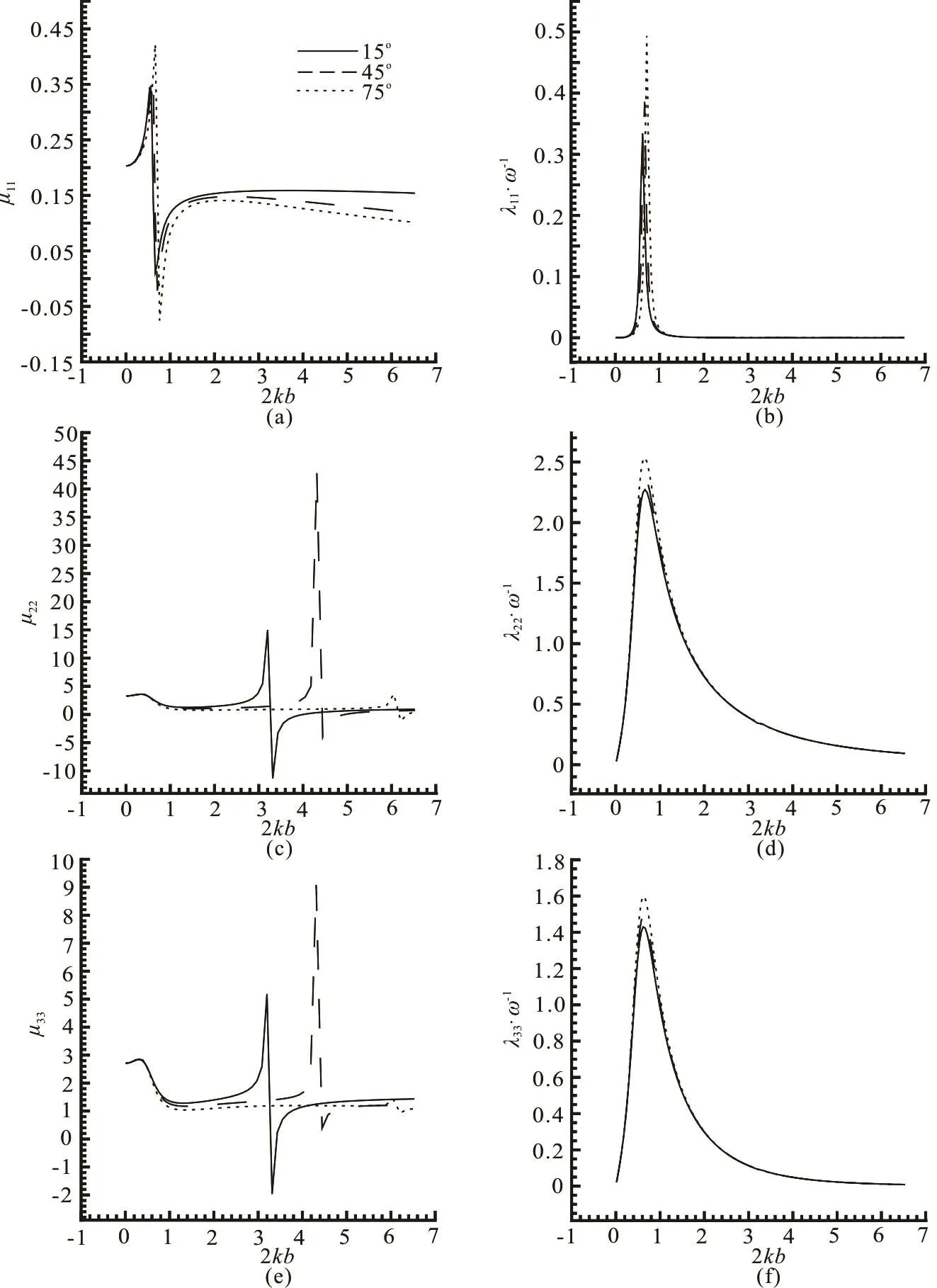
Fig.6 Effect of angle of incidence on hydrodynamic coefficients with h / h 1 =3, b / h 1 =0.5, a/ b=0.5
The real part and the imaginary part of the vertical force for different values of a/b are shown in Figs.5(a) and 5(b), respectively. Since the force comes from the pressure over the horizontal bottom, the opening evidently has a large effect. It can be seen from Fig.5(a) that the absolute values of the peaks in Re(f1) are 0.868, 0.458, 0.220, 0.063 for a / b = 0.2,0.4, 0.6, 0.8, followed by a decline of 47.2%, 52%,71.4%, and it is seen from Fig.5(b) that the absolute values of the peaks in I m(f1) are 1.433, 0.737, 0.356,0.102, followed by a decline of 48.6%, 51.7%, 71.3%.Figures 5(c)-5(f) indicate that the results of the real part of the exciting force are basically the same for the sway and roll modes at different values of a / b, but the results of the imaginary part sees obvious peak values.
The opening is found to have little effect on the horizontal force and the sloshing frequency of the moon pool but have a large effect on the vertical force and the piston frequency of the moon pool. With the opening at the bottom increasing, the vertical force increases and the amplification increases significantly.Also, with the increase of the opening size at the bottom, the frequency of piston increases, but the am-plification decreases and becomes not significant.
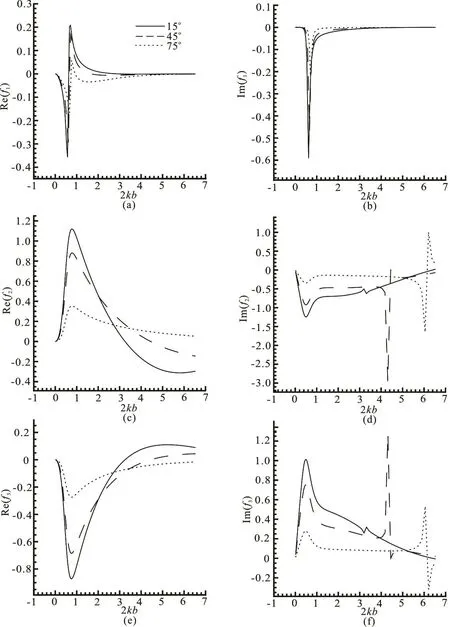
Compared with the data of Zhou et al.[12], for different sizes of the opening, the angle of incidence has a certain impact on the sway and roll motions of the floating body.
5.3 Effects of the angle of incidence
Consider the effect of the angle of incidence on the hydrodynamic coefficients for the cases of /hare considered, namely, the angle of incidence θ isdynamic effects of the angle of incidence. The cases with different incident angles were also studied by Zheng et al.[13]. The heave added mass and the damping coefficient at different angles of incidence are shown in Figs.6(a) and 6(b). It can be seen from Fig.6(a) that there are peaks inμ11at 2kb≈0.535,0.617, 0.662 for θ = 15o, 4 5oand 7 5o, respectively.Figure 6(b) shows that the variation of the heave added mass and the damping coefficient are more or less the same at different angles of incidence. And it can be seen from Figs.6(c)-6(f) that the behavior of the hydrodynamic coefficients for the sway and roll modes at different angles of incidence is somewhat different. The variations of the added mass at different angles of incidence are quite different, especially in the vicinity of a peak, but the difference of the damping coefficients is small. More specifically, in Figs.6(c) and 6(e), we can see peaks in the added mass at 2kb≈3.20, 4.31, 6.05 for θ = 15o, 4 5oand 7 5o,respectively. All these suggest that the different angles of incidence do significantly affect the first resonant frequency of the sway and roll modes.
According to the analysis, the angle of incidence has very small effect on the heave added mass, and with the increase of the angle of incidence, the added mass for the sway and roll modes increases. However,the relevant results should be further verified with experimental or numerical data when the incident angle is larger thano45.
The real part and the imaginary part of the vertical force at different angles of incidence are shown in Figs.7(a) and 7(b), respectively. It can be seen from Fig.7(a) that the absolute values of the peaks in R e(f1) are 0.357, 0.294, 0.167 for θ = 15o,45oand 7 5o, respectively, followed by a decline of 17.6%, 43.2%, and from Fig.7(b) the absolute values of the peaks in Im( f2)are 0.592, 0.472, 0.228,followed by a decline of 20.3%, 51.7%. Figs.7(c)-7(f)indicate that the results of the real and imaginary parts of the exciting force are markedly different for those of the sway and roll modes for different angles of incidence. Figures 7(c) and 7(e) show that the maximum of the real parts of the horizontal force component and the roll moment at 2 k b = 0.760 are 1.119,0.880, 0.352 and 0.873, 0.686, 0.275 for θ = 15o,45oand 7 5o, followed by a decline of 21.4%, 60%and 21.4%, 60%, respectively. Figures 7(d) and 7(f)show that the first peaks of the imaginary parts of the horizontal force component and the roll moment are similar to those of the real parts. However when the angle of incidence increases, the curve of the imaginary part shows more clearly the peak.
The effects of the incidence angle on the vertical wave force are not significant. By comparison, the incidence angle has a great influence on the horizontal wave force and the roll moment, especially in the case of small wave number (2 k b = 1.0). With the increase of the angle of incidence, the horizontal wave force and the roll moment decrease.
6. Conclusions
An analytical-numerical solution procedure based on subdividing the fluid domain and the method of separation of variables is adopted to study the radiation and diffraction problem due to the interaction of linear water waves with an infinitely long rectangular structure with an opening at its bottom floating in oblique seas. It is found that in the oblique seas the external excitation frequency that can lead to the resonance of a rectangular tank depends on the wave direction and the wave number of the incident wave.In the cases of sway and roll motions, the frequencies corresponding to the peaks of the hydrodynamic coefficient curves are very close to the first natural frequency of the rectangular tank with the same size,which shows that the frequency of a two-dimensional rectangular moon pool can be obtained from the frequency formula of the rectangular tank with the same size. The hydrodynamic coefficient curves of the symmetrical movement (heaving) also have a peak.From the fluctuation in the moon pool at the corresponding frequency, it is found that the surface of the water is nearly horizontal, which indicates the existence of the piston phenomenon. The opening is found to have little effect on the horizontal force but a great effect on the vertical force, which can be expected from the physical characteristics of the problem. And compared with the data of Zhou et al.[12], in the cases of opening of different sizes, the angle of incidence has a certain impact on the sway and roll motions of the floating body.
In this study, the three-dimensional problem is simplified as a two-dimensional problem, which does have some limitations, but it provides some important insight. In the future study, we can use the numerical method to study the three-dimensional problem of the moon pool and discuss the limits of the acceptable angle of incidence.
[1] Zhang H. S., Zhou H. W. Wave radiation and diffraction by a two-dimensional floating body with an opening near a side wall [J]. China Ocean Engineering, 2013, 27(4): 437-450.
[2] Zheng Y. H., Liu P. F., Shen Y. M. et al. On the radiation and diffraction of linear water waves by an infinitely long rectangular structure submerged in oblique seas [J]. Ocean Engineering, 2007, 34(3): 436-450.
[3] Zheng Y. H., Shen Y. M., Ng C. O. Effective boundary element method for the interaction of oblique waves with long prismatic structures in water of finite depth [J].Ocean Engineering, 2008, 35(5-6): 494-502.
[4] Politis C. G., Papaleaxandirs M. V., Athanassoulis G. A. A boundary integral equation method for oblique waterwave scattering by cylinders governed by the modified Helmholtz equation [J]. Applied Ocean Research, 2002,24(4): 215-233.
[5] Gesraha M. R. Applied of shaped floating breakwater in oblique waves: I. Impervious rigid wave boards [J].Applied Ocean Research, 2006, 28(5): 327-338.
[6] Eva L., Constantine M., Demos C. A. Hydroelastic analysis of a flexible mat-shaped floating breakwater under oblique wave action [J]. Journal of Fluids and Structures,2012, 31: 103-124.
[7] Molin B. On the piston and sloshing modes in moonpools[J]. Journal of Fluid Mechanics, 2001. 430: 27-50.
[8] Zheng Y. H., You Y. G., Shen Y. M. On the radiation and diffraction of water waves by a rectangular buoy [J].Ocean Engineering, 2004, 31(8-9): 1063-1082.
[9] Mclver P. Complex resonances in the water-wave problem for a floating structure [J]. Journal of Fluid Mechanics,2005, 536: 423-443.
[10] Faltinsen O. M., Rognebakke O. F., Timokha A. N. Twodimensional resonant piston-like sloshing in a moonpool[J]. Journal of Fluid Mechanics, 2007, 575: 359-397.
[11] Lee D., Hong S. Y., Lee G. J. Theoretical and experimental study on dynamic behavior of a damaged ship in waves [J]. Ocean Engineering, 2007, 34(1): 21-31.
[12] Zhou H. W., Wu G. X., Zhang H. S. Wave radiation and diffraction by a two-dimensional floating rectangular body with an opening at its bottom [J]. Journal of Engineering Mathematics, 2013, 83(1): 1-22.
[13] Zheng Y. H., Shen Y. M., You Y. G. et al. Wave radiation by a floating rectangular structure in oblique seas [J].Ocean Engineering, 2006, 33(1): 59-81.
[14] Shen Y. M., Zheng Y. H., You Y. G. On the radiation and diffraction of linear water waves by a rectangular structure over a sill. Part I. Infinite domain of finite water depth [J].Ocean Engineering, 2005, 32(8-9): 1073-1097.
[15] Bhattacharjee J., Soares C. G. Oblique wave interaction with a floating structure near a wall with stepped bottom[J]. Ocean Engineering, 2011, 38(13): 1528-1544.
[16] Ursell F. On the heaving motion of a circular cylinder on the surface of a fluid [J]. Quarterly Journal of Mechanics and Applied Mathematics, 1949, 2(2): 218-231.
[17] Wu G. X. On the second order wave reflection and transmission by a horizontal cylinder [J]. Applied Ocean Research, 1991, 13(2): 58-62.
[18] Zhang W., Zou Z. J. Time domain simulations of radiation and diffraction by a Rankine panel method [J]. Journal of Hydrodynamics, 2015, 27(5): 635-646.
[19] Chen X., Liang H. Wavy properties and analytical modeling of free-surface flows in the development of the multidomain method [J]. Journal of Hydrodynamics, 2016,28(6): 971-976.
[20] Mei C. C. The applied dynamics of ocean surface waves,Vol. 1, Advanced series on ocean engineering [M]. 2nd Edition, Singapore: World Scientific, 1989.
[21] Wu G. X. Second-order resonance of sloshing in a tank [J].Ocean Engineering, 2007, 34(17): 2345-2349.
[22] Yeung R. W., Seah R. K. M. On Helmholtz and higherorder resonance of twin floating bodies [J]. Journal of Engineering Mathematics, 2007, 58(1-4): 251-265.
- 水动力学研究与进展 B辑的其它文章
- Bubbly shock propagation as a mechanism of shedding in separated cavitating flows *
- A sharp interface approach for cavitation modeling using volume-of-fluid and ghost-fluid methods *
- On the numerical simulations of vortical cavitating flows around various hydrofoils *
- Experimental measurement of tip vortex flow field with/without cavitation in an elliptic hydrofoil *
- The effect of water quality on tip vortex cavitation inception *
- Novel scaling law for estimating propeller tip vortex cavitation noise from model experiment *

